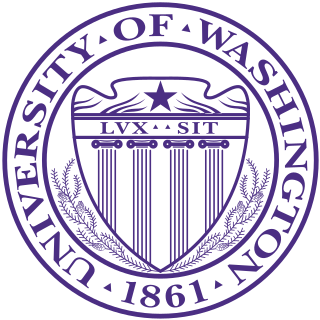
The University of Washington is a public research university in Seattle, Washington, United States. Founded in 1861, the University of Washington is one of the oldest universities on the West Coast of the United States.

Lake Union is a freshwater lake located entirely within the city limits of Seattle, Washington, United States. It is a major part of the Lake Washington Ship Canal, which carries fresh water from the much larger Lake Washington on the east to Puget Sound on the west. The easternmost point of the lake is the Ship Canal Bridge, which carries Interstate 5 over the eastern arm of the lake and separates Lake Union from Portage Bay. Lake Union is the namesake of the neighborhoods located on three of its shores: Eastlake, Westlake and South Lake Union. Notable destinations on the lake include Lake Union Park, the Museum of History & Industry (MOHAI), and the Center for Wooden Boats on the southern shore and Gas Works Park on the northern shore.

The University District is a neighborhood and a major district in central northeastern Seattle, Washington, comprising several distinct neighborhoods. The main campus of the University of Washington (UW) is located in the district, lending its name to both the district as well as University Way NE.

Green Lake is a neighborhood in north central Seattle, Washington. Its centerpiece is the lake and park after which it is named.

The Daily of the University of Washington is the student newspaper of the University of Washington in Seattle, Washington. It is staffed entirely by University of Washington students, excluding the publisher, advertising adviser, accounting staff, and delivery staff.

The Washington Huskies are the intercollegiate athletic teams that represent the University of Washington, located in Seattle. The school competes at the National Collegiate Athletic Association (NCAA) Division I level as a member of the Big Ten Conference.
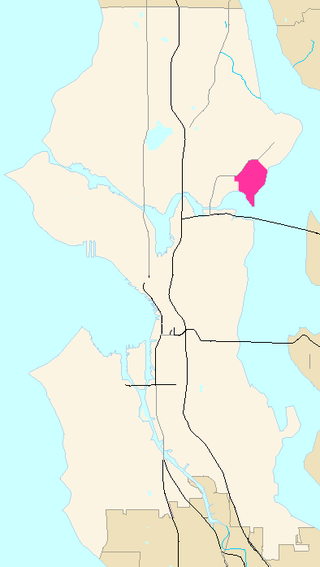
Laurelhurst is a residential neighborhood in northeastern Seattle, Washington, US. It is bounded on the northeast by Ivanhoe Place N.E., beyond which is Windermere; on the northwest by Sand Point Way N.E. and N.E. 45th Street, beyond which are Hawthorne Hills, Ravenna, and University Village; on the west by Mary Gates Memorial Drive N.E., beyond which is the East Campus of the University of Washington; on the southwest by Union Bay; and on the east by Lake Washington. Seattle Children's Hospital is located in its northwest corner. Once a seasonal campground of the Duwamish people, the neighborhood has been a part of Seattle since its annexation in 1910.
The Associated Students of the University of Washington (ASUW) is the student association at the University of Washington. It is funded and supported by the University's Services and Activities Fee with which it provides services that directly and indirectly benefit student life. The ASUW consists of over 80 student employees and 500 volunteers, and the organization spends approximately $1.5 million annually to run events, lobby the legislature, and fund various Registered Student Organizations as they put on their own programs.

Pocock Racing Shells is a Seattle, Washington-based racing shells manufacturer, founded in 1911.
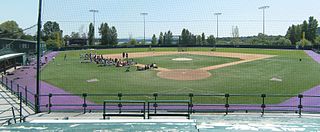
Husky Ballpark is a college baseball park in the Northwestern United States, located on the campus of the University of Washington in Seattle. Opened 27 years ago in 1998, it is the home field of the Washington Huskies of the Pac-12 conference. The playing field was renamed for donor Herb Chaffey in May 2009.

PLU Crew is the varsity rowing program for Pacific Lutheran University in Tacoma, Washington. The team was founded in 1964 as a joint program with University of Puget Sound. Today the team consists of Men's and Women's programs for both Varsity and Novice rowers, and competes as a member of the Northwest Collegiate Rowing Conference (NCRC) and Western Intercollegiate Rowing Association (WIRA).

Hiram Boardman Conibear was an American football and rowing coach. He served as head football coach for the University of Montana from 1903 to 1904, compiling a record of 5–7. Conibear was head rowing coach at the University of Washington from 1907 to 1917, coaching both the men's and women's rowing teams. He developed the distinctive style that became known as the Conibear stroke that "had an effect on the sport that lasted for 30 years".

George Yeomans Pocock was a leading designer and builder of racing shells in the 20th century. He was also a crew coach and an elder statesman of the sport.

The Husky Union Building is a building at the University of Washington that is known as the center of campus as it functions as an event center, a place for student engagement, and a place intended to improve student experience.
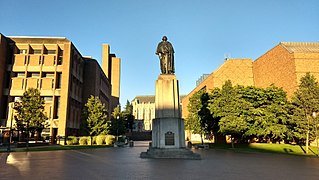
The Campus of the University of Washington is located in the University District of Seattle. Campus buildings are categorized by the major street or vicinity on which they are located on campus. In 2011, Slate magazine and Travel + Leisure described the Seattle campus as one of the most beautiful university campuses in the United States.
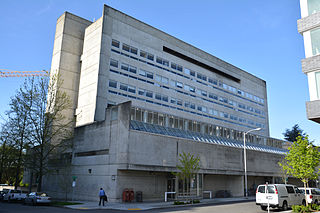
John T. Condon Hall is an academic building of the University of Washington in Seattle, Washington. The building formerly housed the UW School of Law. The hall was named after John T. Condon, the first dean of the School of Law.
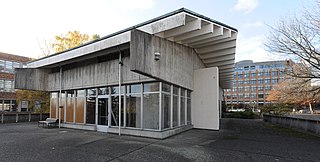
The More Hall Annex, formerly the Nuclear Reactor Building, was a building on the campus of the University of Washington (UW) in Seattle, Washington, United States, that once housed a functional nuclear research reactor. It was inaugurated in 1961 and shut down in 1988, operating at a peak of 100 kilowatts thermal (kWt), and was officially decommissioned in 2007.

The Conibear Shellhouse is a rowing training and support facility in Seattle, Washington, on the campus of the University of Washington. It is used by the men's and women's rowing teams of the Washington Huskies. The building was completed in 1949 and renovated in 2005. It is located on Lake Washington, near the Lake Washington Ship Canal.

Gerberding Hall is an academic building located on the campus of the University of Washington in Seattle.

Fritz Hedges Waterway Park, also known as Portage Bay Park, is a 3.5-acre (0.014 km2) park on the north shore of Portage Bay in the neighborhood of University District of Seattle, Washington.





















